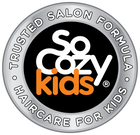There’s a reason we refer to lice as pests. When you’re a busy parent and pesky head lice make their way onto your child, identifying and treating them becomes Priority #1! The fact that head lice can be asymptomatic for up to 4-6 weeks after initial infestation means your child could unknowingly spread their lice to your whole family. If this ‘bugs' you, the good news is that there are many lice-prevention techniques you can employ to keep your family pest-free.
Knowledge is power, and the best way to be armed against a lice infestation is to know how lice appear and what symptoms they may present. Below is a list of six head lice symptoms to look out for.
Itchiness
Itching (pruritus) is caused by an allergic reaction to the lice bites. It can take up to six weeks before itchiness on the scalp is present, so it’s important to be vigilant and aware of accompanying symptoms.
Sensation of movement on head
Head lice are not always accompanied by an itching sensation. However, if lice are crawling on your head, it is likely that you may feel them ‘moving about the cabin’, so to speak. If you feel any crawling or tickling sensation in your hair, that is a sign to check for lice.
The appearance of lice eggs (nits)
Lice eggs will appear on the scalp before they hatch into full-grown lice. These nits are extremely small, white, circular eggs. Because of their tiny size, they can be hard to spot and are often mistaken for dandruff. Nits are easiest to spot near the ears and nape of the neck, and unlike dandruff, they can be difficult to remove from the hair shaft.
The appearance of adult lice and nymphs
Perhaps the most visible head lice symptom is seeing the lice, themselves. Adult lice are around the size of a sesame seed, and tan or grey-white in color. Nymphs (baby lice) are about half the size of an adult louse, and grow to full size within 1-2 weeks.
Red bumps or sores
Red bumps and scalp irritation may appear as a result of scratching. Excess scratching may lead to a larger rash or even a bacterial infection, so if itchiness is present, it is important to mitigate scratching.
Irritability and sleeplessness
Due to itchiness or general discomfort, lice can cause irritability and a lack of sleep.
All it takes is one lousy louse to eventually send you and your family into pest-ridden disarray. In addition to looking out for the symptoms of head lice, there are a few active steps you can take to help keep lice at bay and far away. Head lice is most commonly spread through head-to-head contact, so encourage your child to keep their distance and to avoid sharing hats or other clothing.
There are also head lice prevention products, like SoCozy’s Boo! Lice Scaring Shampoo, that are designed to help incorporate lice prevention into kid’s everyday hair care. These products use natural lice repellents such as tea tree and peppermint oil to help ‘scare’ away lice.
Head lice are not always predictable, which is why it’s important to be prepared. By being aware of head lice symptoms and taking steps towards prevention (like the use of lice-scaring products), you can give your family pest-free peace of mind.


